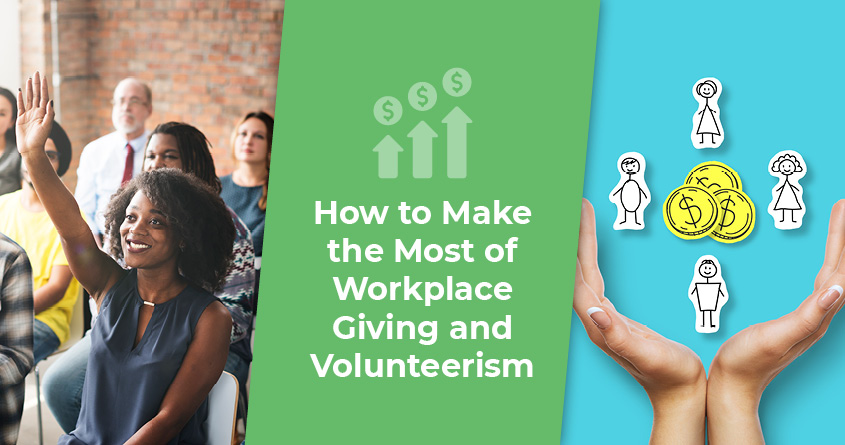When it comes to optimizing your organization’s fundraising strategy, workplace giving and volunteerism may not be the first two ideas that come to your mind. But there’s a lot more that goes into an effective supporter engagement strategy than collecting monetary donations. Workplace giving and volunteerism can significantly elevate your fundraising efforts if you let them.
In this guide, we’ll cover the basics of strategic workplace giving and volunteer efforts. Plus – how to use each opportunity to drive engagement success.
- What is volunteerism?
- What is workplace giving?
- Why should you incorporate these types of programs in your overall strategy?
- Tips for leveraging workplace giving + volunteer opportunities
Each of your organization’s supporters goes through a different donor journey. For some, giving financially to the cause is their focus. Others may prefer the hands-on effort that comes with volunteerism.
Others still might opt for a combination of each, plus the opportunity to elevate their contributions’ impact with workplace philanthropy through their employers. Either way, your nonprofit benefits greatly. This is especially true when you have a specific strategy in place to make the most of different types of non-traditional giving.
Ready to find out how? Let’s begin.
What is volunteerism?
Volunteerism is the process of nonprofit organizations and other community groups leveraging freely given labor from individuals donating their time. Organizations are able to get more done for their missions while using less of their own time and resources.

Here are a few examples of volunteer opportunities:
- Working fundraising events or other revenue-generating activities
- Clerical activities like answering phone calls or filing paperwork
- Offering unique skill sets such as copywriting, graphic design, or social media management
- Partaking in virtual volunteerism
- And many more!
While many choose to participate in nonprofit volunteerism on their own, others opt to volunteer in groups as well—including corporate groups. The possibilities are endless, with many volunteerism ideas varying depending on the sector in which your organization operates. While volunteerism
What is workplace giving?
Workplace giving is a popular subcategory of corporate philanthropy. This is essentially a way for-profit companies participate in social good by supporting nonprofits of all shapes and sizes. Employees being directly involved in a hands-on way is what makes workplace giving stand out.
These programs include:
- Matching gifts — Companies agree to match donations made by their employees to qualifying nonprofit causes, most often at a 1:1 ratio.
- Volunteer grants — Companies that offer volunteer grants provide grant funding to the nonprofit organizations their employees volunteer their time with, often by contributing a predetermined grant amount per hour volunteering.
- Volunteer time off — Companies that provide volunteer time off, or VTO, offer their employees additional paid time off (above and beyond existing PTO hours) to volunteer with nonprofit causes.
- Charitable giving stipends — Companies provide charitable dollars to their employees, who can then contribute the funding to the nonprofit organizations of their choice.
Nonprofits like yours can benefit greatly from workplace giving initiatives. More than likely, a substantial portion of your existing and prospective supporters work for companies that offer these programs.
By strategically engaging with these individuals, you can encourage participation in workplace giving. This participation directly increases the corporate funding being funneled to your organization and mission.
Why should you incorporate these types of programs in your overall strategy?
It’s important to remember that when it comes to fundraising and donor engagement, monetary giving is not the only kind of support that matters. Volunteerism (both individually and in corporate groups), along with other types of workplace giving, can have substantial advantages for the organizations that make the most of them.
For example, some individuals may lack the funds to contribute financial but still want to get involved with your organization.You certainly don’t want to overlook opportunities they have to support you with their time instead.
Meanwhile, others may have already donated their hard-earned dollars and are looking for ways to do more. In this case, you won’t want to miss out on workplace giving opportunities that can stretch their existing support even further—such as matching gifts.
Highlighting additional opportunities for involvement (including, but not limited to) volunteering and workplace giving participation tends to bring donor and supporter engagement to the next level—or two.
Individuals love participating in these opportunities knowing the substantial ways they benefit the causes they care about, and they feel particularly connected to the organizations without being asked to reach back into their own wallets.
These unique and powerful giving avenues can help make the most of an organization’s available resources while also having a significant, tangible impact on the mission.

Tips for leveraging workplace giving + volunteer opportunities
Now, how can you put these ideas into action? Consider the following best practices, and see how they can be incorporated into your organization’s overall strategy.
1. Promote multiple ways for individuals to get involved.
One of the most significant roadblocks to workplace giving and volunteerism success is that nonprofit supporters are often unaware of the initiatives in the first place. Double the Donation research reports that despite nearly 27 million individuals being employed by companies with matching gift programs, more than 78% have no idea about the program.
The same thing can be said about many other types of available involvement—including volunteer grants, paid volunteer time off, and other engagement opportunities. It’s a good idea to take a proactive approach to market the initiatives to your supporters.
This might mean posting about the programs on social media, sending dedicated email messages, incorporating information across your nonprofit website, and more.
2. Provide detailed instructions on participation opportunities.
Clicking a “donate now” button and following the provided prompts is a fairly simple way to support a nonprofit organization. Volunteering with the cause or participating in a workplace giving program, however, can be a bit more difficult—particularly when it comes to determining how to get started.
In order to drive participation in these types of initiatives, be sure to lay out exactly what your supporters can expect from the process. You should consider establishing an online application form for volunteer programs. This form should include event/shift sign up and detailed information of what will be asked of volunteers upon their arrival.
Meanwhile, when it comes to workplace giving, you’ll want to share company-specific program information and process overviews. If a donor works for Walt Disney World, for example, be sure to provide them with information on matching gifts and volunteer grants (e.g., minimum and maximum donation amounts or volunteer hours), eligibility requirements, submission deadlines, and even links to the company’s online request portal.
3. Communicate gratitude for all types of support.
We’ve written before about the various ways to say thank you to donors for their support of organizations like yours. But something that’s often overlooked is the vitality of communicating appreciation to all supporters—regardless of whether they contributed financially, gave their time, or participated in a workplace giving program—or all of the above.
Otherwise, you risk making those furthering your mission in non-financial ways feel second-rate. And when that’s the case, individuals are not likely to continue participating in the programs in the future. Not to mention, they contributed to your organization in substantial ways and deserve the recognition of doing so—whether they gave out of their own pockets or not.
Key Takeaways
Incorporating non-traditional giving opportunities into your nonprofit’s overall fundraising strategy is essential for building and maintaining relationships with your donors and more.
Individuals love increasing the impact of their support through workplace giving initiatives and seeing the tangible effects of their efforts with volunteerism opportunities. These tactics keep supporters coming back time and time again and ultimately result in elevated success for your organization and its mission.
About the Author




